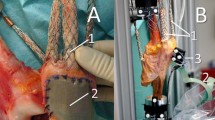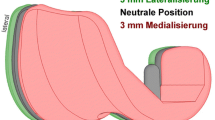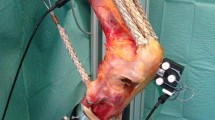Abstract
Purpose
To demonstrate that lateral to medial patellofemoral force and pressure ratios could be a surrogate marker of retinacular tension and patellar tracking.
Methods
The patellofemoral forces of six knees from three fresh-frozen half-body female cadavers were evaluated with a capacitive sensor under simulated operative conditions in six staged clinical scenarios: native knees, knee arthroplasty without patellar resurfacing, resurfaced knee and patella, resurfaced knee and patella with lateral release, gender-specific knee arthroplasty with patella resurfacing, and gender-specific knee arthroplasty with lateral release. Maximum force and peak pressure were simultaneously recorded during three to four ranges of motion. Average values were compared between lateral and medial patellofemoral compartments as an objective measure of patellar tracking for the different settings.
Results
Significant differences in lateral and medial force and pressure differentials were seen in most scenarios despite clinically normal patellar tracking. Lateral to medial ratios of maximum force and peak pressure significantly increased after TKA (2.9, 2.1) and after patella resurfacing (2.8, 2.6) compared to the native knee (1.6, 1.8). Addition of a lateral release in resurfaced knees decreased the ratio of lateral to medial patellofemoral forces and pressures as did gender knee arthroplasty (1.5 and 1.1, 2 and 1.3, respectively). Pressure and force values most closely resembled the native knee in the resurfaced knee/resurfaced patella with lateral release and in the gender knee arthroplasty scenarios.
Conclusions
Use of lateral to medial patellofemoral force ratios as a surrogate objective marker for patellar tracking was validated in this study by decreasing ratios observed after lateral release in TKA and with gender-specific implants.



Similar content being viewed by others
References
Barink M, Meijerink H, Verdonschot N, van Kampen A, de Waal Malefijt M (2007) Asymmetrical total knee arthroplasty does not improve patella tracking: a study without patella resurfacing. Knee Surg Sports Traumatol Arthrosc 15:184–191
Becher C, Heyse TJ, Kron N, Ostermeier S, Hurschler C, Schofer MD, Fuchs-Winkelmann S, Tibesku CO (2009) Posterior stabilized TKA reduce patellofemoral contact pressure compared with cruciate retaining TKA in vitro. Knee Surg Sports Traumatol Arthrosc 17:1159–1165
Bellemans J, Vandenneucker H, Vanlauwe J (2005) Total knee replacement. Current Orthopaedics 19:446–452
Belvedere C, Catani F, Ensini A, Moctezuma de la Barrera JL, Leardini A (2007) Patellar tracking during total knee arthroplasty: an in vitro feasibility study. Knee Surg Sports Traumatol Arthrosc 15:985–993
Bengs BC, Scott RD (2006) The effect of patellar thickness on intraoperative knee flexion and patellar tracking in total knee arthroplasty. J Arthroplasty 21:650–655
Benjamin JB, Szivek JA, Hammond AS, Kubchandhani Z, Matthews AI Jr, Anderson P (1998) Contact areas and pressures between native patellas and prosthetic femoral components. J Arthroplasty 13:693–698
Chew JT, Stewart NJ, Hanssen AD, Luo ZP, Rand JA, An KN (1997) Differences in patellar tracking and knee kinematics among three different total knee designs. Clin Orthop Relat Res 345:87–98
Clarke HD, Hentz JG (2008) Restoration of femoral anatomy in TKA with unisex and gender-specific components. Clin Orthop Relat Res 466:2711–2716
Csintalan RP, Schulz MM, Woo J, McMahon PJ, Lee TQ (2002) Gender differences in patellofemoral joint biomechanics. Clin Orthop Relat Res 402:260–269
D’Lima DD, Chen PC, Kester MA, Colwell CW Jr (2003) Impact of patellofemoral design on patellofemoral forces and polyethylene stresses. J Bone Joint Surg Am 85(Suppl 4):85–93
Dalury DF, Mason JB, Murphy JA, Adams MJ (2009) Analysis of the outcome in male and female patients using a unisex total knee replacement system. J Bone Joint Surg Br 91:357–360
Elias JJ, Kilambi S, Goerke DR, Cosgarea AJ (2009) Improving vastus medialis obliquus function reduces pressure applied to lateral patellofemoral cartilage. J Orthop Res 27:578–583
Fuchs S, Schutte G, Witte H, Rosenbaum D (2000) Retropatellar contact characteristics in total knee arthroplasty with and without patellar resurfacing. Int Orthop 24:191–193
Glaser FE, Gorab RS, Lee TQ (1999) Edge loading of patellar components after total knee arthroplasty. J Arthroplasty 14:493–499
Greene KA (2007) Gender-specific design in total knee arthroplasty. J Arthroplasty 22(7 Suppl 3):27–31
Healy WL, Wasilewski SA, Takei R, Oberlander M (1995) Patellofemoral complications following total knee arthroplasty. Correlation with implant design and patient risk factors. J Arthroplasty 10:197–201
Heyse TJ, Becher C, Kron N, Ostermeier S, Hurschler C, Schofer MD, Tibesku CO, Fuchs-Winkelmann S (2010) Patellofemoral pressure after TKA in vitro: highly conforming versus posterior stabilized inlays. Arch Orthop Trauma Surg 130:191–196
Hsu HC, Luo ZP, Rand JA, An KN (1997) Influence of lateral release on patellar tracking and patellofemoral contact characteristics after total knee arthroplasty. J Arthroplasty 12:74–83
Johanson NA, Cerynik DL, Pasquale M (2011) Measuring patellofemoral forces and pressures in a simulated operating room environment. J Arthroplasty 26:137–143
Kainz H, Reng W, Augat P, Wurm S (2012) Influence of total knee arthroplasty on patellar kinematics and contact characteristics. Int Orthop 36:73–78
Kawahara S, Matsuda S, Fukagama S, Mitsuyasu H, Nakahara H, Higaki H, Shimoto T, Iwamoto Y (2012) Upsizing the femoral component increases patellofemoral contact force in total knee replacement. J Bone Joint Surg Br 94:56–61
Kim YH, Choi Y, Kim JS (2010) Comparison of standard and gender-specific posterior-cruciate-retaining high-flexion total knee replacements: a prospective, randomised study. J Bone Joint Surg Br 92:639–645
Kurtz SM, Lau E, Ong K, Zhao K, Kelly M, Bozic KJ (2009) Future young patient demand for primary and revision joint replacement: national projections from 2010 to 2030. Clin Orthop Relat Res 467:2606–2612
Kurtz SM, Ong KL, Lau E, Widmer M, Maravic M, Gomez-Barrena E, Manno V, Torre M, Walter WL, de Steiger R, Geesink RG, Peltola M, Roder C (2011) International survey of primary and revision total knee replacement. Int Orthop 35:1783–1989
Lee TQ, Gerken AP, Glaser FE, Kim WC, Anzel SH (1997) Patellofemoral joint kinematics and contact pressures in total knee arthroplasty. Clin Orthop Relat Res 340:257–266
MacDonald SJ, Charron KD, Bourne RB, Naudie DD, McCalden RW, Rorabeck CH (2008) The John Insall Award: gender-specific total knee replacement: prospectively collected clinical outcomes. Clin Orthop Relat Res 466:2612–2616
Martinelli L, Hurschler C, Rosenbaum D (2006) Comparison of capacitive versus resistive joint contact stress sensors. Clin Orthop Relat Res 447:214–220
Matsuda S, Ishinishi T, White SE, Whiteside LA (1997) Patellofemoral joint after total knee arthroplasty. Effect on contact area and contact stress. J Arthroplasty 12:790–797
Ogata K, Ishinishi T, Hara M (1997) Evaluation of patellar retinacular tension during total knee arthroplasty. Special emphasis on lateral retinacular release. J Arthroplasty 12:651–656
Ostermeier S, Holst M, Hurschler C, Windhagen H, Stukenborg-Colsman C (2007) Dynamic measurement of patellofemoral kinematics and contact pressure after lateral retinacular release: an in vitro study. Knee Surg Sports Traumatol Arthrosc 15:547–554
Outerbridge RE (1961) The etiology of chondromalacia patellae. J Bone Joint Surg Br 43-B:752–757
Peretz JI, Driftmier KR, Cerynik DL, Kumar KS, Johanson NA (2012) Does lateral release change patellofemoral forces and pressures? Clin Orthop Relat Res 470:903–909
Pickering T, Berend M (2008) Patella resurfacing in total knee arthroplasty: the sum of all parts. Semin Arthroplasty 19:112–116
Putti AB, Arnold GP, Cochrane L, Abboud RJ (2007) The Pedar in-shoe system: repeatability and normal pressure values. Gait Posture 25:401–405
Rae P, Noble J, Hodgkinson J (1990) Patellar resurfacing in total condylar knee arthroplasty: technique and results. J Arthroplasty 5:259–265
Rhee S, Haddad F (2008) Patello-femoral joint in total knee replacement. Curr Orthop 22:132–138
Sharma A, Leszko F, Komistek RD, Scuderi GR, Cates HE Jr, Liu F (2008) In vivo patellofemoral forces in high flexion total knee arthroplasty. J Biomech 41:642–648
Singerman R, Gabriel SM, Maheshwer CB, Kennedy JW (1999) Patellar contact forces with and without patellar resurfacing in total knee arthroplasty. J Arthroplasty 14:603–609
Spitzer AIVK (1995) Patellar considerations in total knee arthroplasty. In: Scuderi G (ed) The patella. Springer, New York, p 315
Stiehl JB (2005) A clinical overview patellofemoral joint and application to total knee arthroplasty. J Biomech 38:209–214
Strachan RK, Merican AM, Devadasan B, Maheshwari R, Amis AA (2009) A technique of staged lateral release to correct patellar tracking in total knee arthroplasty. J Arthroplasty 24:735–742
Varadarajan KM, Gill TJ, Freiberg AA, Rubash HE, Li G (2009) Gender differences in trochlear groove orientation and rotational kinematics of human knees. J Orthop Res 27:871–878
Wilson DR, Apreleva MV, Eichler MJ, Harrold FR (2003) Accuracy and repeatability of a pressure measurement system in the patellofemoral joint. J Biomech 36:1909–1915
Xu C, Chu X, Wu H (2007) Effects of patellar resurfacing on contact area and contact stress in total knee arthroplasty. Knee 14:183–187
Acknowledgments
Zimmer, Inc. (Warsaw, IN, USA) provided funding by sponsoring the cadavers, TKA components, and laboratory time. Zimmer also provided the funding for the study statistician. Zimmer did not play any role in the interpretation of the data, writing of the manuscript, or decision to submit the manuscript.
Author information
Authors and Affiliations
Corresponding author
Rights and permissions
About this article
Cite this article
King, J.J., Chakravarty, R., Cerynik, D.L. et al. Decreased ratios of lateral to medial patellofemoral forces and pressures after lateral retinacular release and gender knees in total knee arthroplasty. Knee Surg Sports Traumatol Arthrosc 21, 2770–2778 (2013). https://doi.org/10.1007/s00167-012-2200-6
Received:
Accepted:
Published:
Issue Date:
DOI: https://doi.org/10.1007/s00167-012-2200-6




